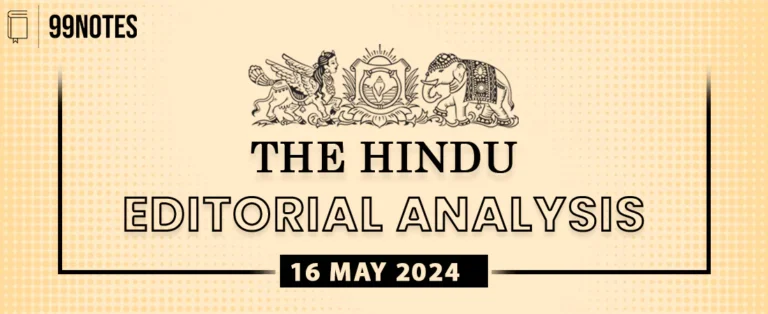6 June 2024 : Hindu Editorial Analysis
1. The roads to India’s redemocratisation, the challenges
| Topic: GS2 – Indian Polity GS2 – Governance |
| Context |
|
The article analyses the aftermath of the 18th Indian general election, highlighting shifts in power dynamics, narrative trends, and potential scenarios for political development. It explores the implications of the Bharatiya Janata Party’s loss of majority and the emergence of coalition politics. |
Introduction: Transition in Indian Democracy
- The 18th Indian general election is perceived as marking the conclusion of a cycle, despite not resulting in a change in power, which is typically indicative of a “critical” election.
- The loss of majority by the ruling party is seen as significant, potentially signalling a transition towards re-democratization under certain conditions.
De-democratization Trajectory
- Over the past decade, India has witnessed a trajectory of de-democratization characterised by the concentration of political and economic power in a few hands.
- This trend has led to the dominance of a select few at the top of the state apparatus, undermining institutions such as Parliament and federalism.
- In the economic sphere, a small group of cronies has controlled resources, exacerbating inequalities while leveraging identity politics, including communal polarisation, to maintain support.
Implications of Power Shift
- While the balance of power has not shifted significantly, there has been a noticeable tilt, as the BJP remains dominant but without a clear majority.
- This necessitates coalition politics for the ruling party for the first time in a decade potentially allowing institutions to regain autonomy.
- Bureaucrats, the judiciary, and the media may find renewed independence as the government’s authority weakens, though the extent to which they resist restrictive laws remains uncertain.
Revitalization of Federalism
- The relative decline of central authority may lead to a revitalization of federalism, with regional parties like the Telugu Desam Party (TDP) and the Janata Dal (United) advocating for state autonomy.
- Coalition dynamics could prompt greater consultation with Chief Ministers on significant decisions, contrasting with past unilateral actions like demonetization and COVID-19 lockdowns.
- The narrative landscape may undergo a shift away from identity politics, particularly Hindutva-based, towards a focus on social equality and justice.
Scenarios for Future Political Dynamics
- Possible scenarios for future political dynamics include a modus vivendi based on concessions to coalition partners like the TDP and JD(U), ensuring stability through substantial but acceptable compromises.
- Alternatively, a worse-case scenario for the present government could emerge if coalition partners push for significant power-sharing arrangements or pursue investigations into controversial figures like Gautam Adani, potentially leading to government instability.
- These scenarios may evolve over time, influenced by factors such as electoral outcomes in key states, opposition mobilisation, and shifts in coalition dynamics.
Role of Civil Society in Democratisation
- Civil society is poised to play a crucial role in India’s democratic rejuvenation, particularly in countering the influence of groups affiliated with the Rashtriya Swayamsevak Sangh (RSS).
- While a transition towards a new era is possible, simply changing leadership at the state level may not suffice to counter entrenched challenges, necessitating broader societal engagement.
Conclusion: Uncertain Path Ahead
- The outcome of the 18th Indian general election suggests a potential transition towards re-democratization, with coalition politics and narrative shifts reshaping the political landscape.
- However, the path forward remains uncertain, contingent on factors such as coalition dynamics, opposition mobilisation, and the resilience of institutions and civil society in the face of ongoing challenges.
| Coalition Governments: |
|
Pros of Coalition Governments: Representation: Coalition governments often represent diverse interests and ideologies, reflecting the broader spectrum of society. Consensus Building: Require consensus and compromise, fostering cooperation among different political parties and reducing polarisation. Stability: Coalition governments can provide stability by preventing single-party dominance and promoting checks and balances. Inclusivity: Ensure the participation of smaller parties and minority groups in the decision-making process, promoting inclusivity. Policy Innovation: Encourage policy innovation and experimentation through collaboration and exchange of ideas among coalition partners. Cons of Coalition Governments: Decision-Making Delays: Require time-consuming negotiations and consensus-building, leading to delays in decision-making and policy implementation. Policy Compromises: Compromises may dilute the effectiveness or coherence of policies, resulting in suboptimal outcomes. Instability: Coalition governments may be prone to instability, with the risk of coalition partners withdrawing support or internal conflicts leading to government collapse. Lack of Accountability: Diffusion of responsibility among coalition partners can lead to a lack of clear accountability and transparency. Gridlock: Disagreements and conflicts among coalition partners can lead to gridlock and inefficiency in governance. |
| Practice Question: Discuss the implications of the 18th Indian general election on the trajectory of Indian democracy, considering shifts in power dynamics, narrative trends, and potential scenarios for political development. Evaluate the role of coalition politics, civil society, and institutional resilience in shaping India’s democratic future. (250 Words /15 marks) |
(Source – The Hindu, International Edition – Page No. – 4)




